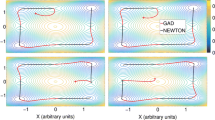Abstract
The system of ordinary differential equations for the method of the gentlest ascent dynamics (GAD) is tested to determine the saddle points of the potential energy surface of some molecules. The method has been proposed earlier [E and Zhou in Nonlinearity 24:1831 (2011)]. We additionally use the metric of curvilinear internal coordinates. By a number of examples, we explain the possibilities of a GAD curve; it can find the transition state of interest by a gentlest ascent, directly or indirectly, or not. A GAD curve can be a model of a reaction path, if it does not contain a turning point for the energy. We further discuss generalized GAD formulas for the search of saddle points of a higher index. We calculate diverse examples.








Similar content being viewed by others
References
Mezey PG (1987) Potential energy hypersurfaces. Elsevier, Amsterdam
Heidrich D, Kliesch W, Quapp W (1991) Properties of chemical interesting potential energy surfaces. Springer Lecture Notes in Chemistry 56, Berlin
Wales DJ (2003) Energy Landsc. Cambridge Univ Press, Cambridge
Heidrich D (1995) In: Heidrich D (ed) The reaction path in chemistry: current approaches and perspectives. Kluwer, Dordrecht
Weinan E, Zhou X (2011) Nonlinearity 24:1831
Samanta A, Weinan E (2012) J Chem Phys 136:124104
Li T, Zhang P, Zhang W (2013) Multiscale Model Simul 11:385
Bofill JM, Quapp W, Caballero M (2013) Chem Phys Lett 583:203
Zeng Y, Xiao P, Henkelman G (2014) J Chem Phys 140:044115
Crippen GM, Scheraga HA (1971) Arch Biochem BioPhys 144:462
Quapp W (2003) J Theor Comput Chem 2:385
Hratchian HP, Schlegel HB (2005) Theory and Applications of Computational Chemistry: the first forty years, Dykstra CE, Frenking G, Kim KS, Scuseria GE (eds) p195 Elsevier, Amsterdam.
Heidrich D, Quapp W (1986) Theor Chim Acta 70:89
Khait YG, Panin AI, Averyanov AS (1994) Int J Quant Chem 54:329
Minyaev RM, Getmanskii IV, Quapp W (2004) Russ J Phys Chem 78:1494
Minyaev RM, Quapp W, Schmidt B, Getmanski IV, Koval VV (2013) Chem Phys 425:170
Maugière FA, Collins P, Ezra GS, Wiggins S (2013) J Chem Phys 138:134118
Nagahata Y, Teramoto H, Li C-B, Kawai Sh, Komatsuzaki T (2013) Phys Rev E Stat Nonlin Soft Matter Phys 88:042923
Quapp W, Bofill JM, Caballero M (2012) Chem Phys Lett 541:122
Doye JPK, Wales DJ (2008) J Chem Phys 116:3777
Schmidt MW, Baldridge KK, Boatz JA, Elbert ST, Gordon MS, Jensen JH, Koseki S, Matsunaga N, Nguyen KA, Su S, Windus TL, Dupuis M, Montgomery JA (1993) J Comput Chem 14:1347
Gordon MS, Schmidt MW (2005) Theory and applications of computational chemistry: the first forty years. In: Dykstra CE, Frenking G, Kim KS, Scuseria GE (eds) Advances in electronic structure theory: GAMESS a decade later. Elsevier, Amsterdam, p 1167
Miller WH, Handy NC, Adams JE (1980) J Chem Phys 72:99
Quapp W, Heidrich D (1984) Theor Chim Acta 66:245
Tachibana A (1981) Theor Chim Acta 58:301
Parlett BN (1980) The symmetric eigenvalue problem. Prentice-Hall, Englewood Cliffs NJ
Hairer E, Nørsett SP, Wanner G (1993) Solving ordinary differential equations I nonstiff problems. 2nd Ed. Springer, Series Computat Math 8, see also www-unige.ch/~hairer/software.html
Hedar A-R (2013) Global optimization test problems. Technical report, see also www-optima.amp.i.kyotou.ac.jp/member/student/hedar/Hedar_files/TestGOhtm
Mühlenbein H, Schomisch D, Born J (1991) Parallel Comp 17:619
Ghosh K, Ozkan SB, Dill KA (2007) J Am Chem Soc 129:11920
Balucani N, Leonori F, Bergeat A, Petrucci R, Casavecchia P (2011) Phys Chem Chem Phys 13:8322
Knyazev VD (2002) J Phys Chem A 106:8741
Carter JT, Cook DB (1991) J Mol Struct Theochem 251:111
Kamarchik E, Rodrigo C, Bowman JM, Reisler H, Krylov AI (2012) J Chem Phys 136:084304
Ryazanov M, Rodrigo C, Reisler H (2012) J Chem Phys 136:084305
Schmidt B, Quapp W (2012) Theor Chem Acc 132:1305
Bofill JM, Quapp W, Caballero M (2012) J Chem Theor Comput 8:927
Marcy TP, Diaz RR, Heard D, Leone SR, Harding LB, Klippenstein SJ (2001) J Phys Chem A 105:8361
Ishida K, Morokuma K, Komornicki A (1977) J Chem Phys 66:2153
Acknowledgments
Financial support from the Spanish Ministerio de Ciencia e Innovación, DGI project CTQ2011-22505 and, in part from the Generalitat de Catalunya projects 2009SGR-1472 is fully acknowledged. We thank the referees for suggestions and comments.
Author information
Authors and Affiliations
Corresponding author
Appendix: Hessian matrix of the Lennard-Jones cluster
Appendix: Hessian matrix of the Lennard-Jones cluster
The potential energy surface (PES) of an n-atomic Lennard-Jones (LJ) cluster is as follows:
where the double sum can be shortened to \(\sum _{i<j}\), and
is the square of the distance between atoms i and j. \(\epsilon , \sigma\) are parameters of the current cluster.
\(V(\mathbf{q})\) is a \(3n\)-dimensional surface over \(I\!\!R^{3n}\). Let \(\mathbf{grad}(\mathbf{q})\) be its gradient vector, \(\nabla _\mathbf{q}V(\mathbf{q})\), and let \(\mathbf{H}(\mathbf{q})\) be the matrix of its second derivatives, the Hessian \(\nabla _\mathbf{q} \mathbf{grad}^T\). We could not find the calculation of the Hessian in the older literature; thus, we give it here in the appendix. We get for the distance between two atoms
A single component of the gradient becomes
If we put the abbreviation
and if we set for simplification of the summation \(T1(ii)=0\), then we can write
and analogously we have for \(i=1,\ldots ,n\)
We further define the abbreviation
Again, we set \(T2(ii)=0\). Then, single components of the Hessian are for the same atom
and
and analogously one gets \(H(x_i,z_i)\) and \(H(y_i,z_i)\) and their symmetric counterparts. If different atoms with numbers i and j are involved, then we get
and
and analogously one gets \(H(x_i,z_j)\) and \(H(y_i,z_j)\) and their symmetric counterparts.
Rights and permissions
About this article
Cite this article
Quapp, W., Bofill, J.M. Locating saddle points of any index on potential energy surfaces by the generalized gentlest ascent dynamics. Theor Chem Acc 133, 1510 (2014). https://doi.org/10.1007/s00214-014-1510-9
Received:
Accepted:
Published:
DOI: https://doi.org/10.1007/s00214-014-1510-9




